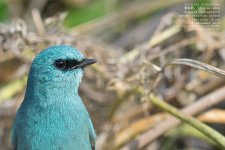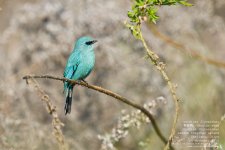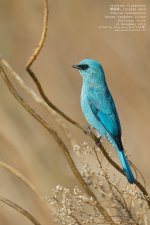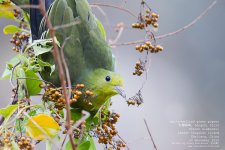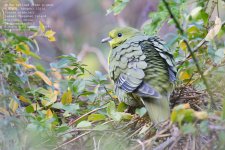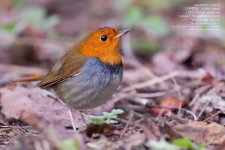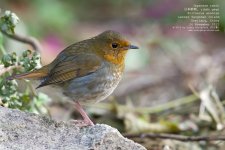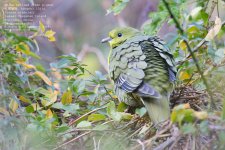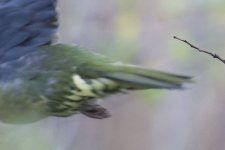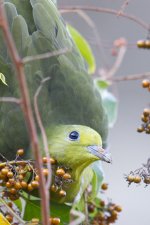...... in September. Garbage Dump Valley was no pristine wonderland then; the prime spot for the varied tits is next to an outhouse, for crying out loud. And while the photographers have contributed to the amount of trash there, and while fake props and luring birds with mealworms are not my style, I think that the claims of "destruction" and "devastation" are exaggerations.
...or they are
in fact far from exaggerations and you either didn't see the original condition or don't want to admit it because
'many of them are my friends' and potential clients perhaps ? Or maybe we have different definitions and you have far more tolerance to large areas of this small area being cleared of vegetation for tripods, and trees and branches that get in the way removed with branches broken off to make perches for the birds (with the mealworms underneath).
I suggest you go back and read McMadd's and my threads again (and yes you said you picked up rubbish but no you did not mention the extensive damage - maybe because you were not aware of it's original condition though the many freshly broken saplings and branches should have been a clue). Pristine ? No. But the
devastation caused to the environment there is horrifying.
And what has the fact the Varied Tits like the location next to an outhouse (which has a dripping tap they drink from and the trees there were loaded with berries) got to do with anything !
.On Saturday, I made two stops to Garbage Dump Valley: in the early morning and in the late afternoon. In the early morning, there were no robins to be seen. By late afternoon, a pair had appeared. Two new Japanese robins arrived! Why would robins be using the Garbage Dump if it's been "ruined" and "devastated"? I counted four varied tits on Saturday, the same number that I counted in September. The tits have survived a long time at the Garbage Dump, despite the photographers.
Surprisingly I doubt birds have yet learnt to be environmentally aware. They use the islands the same way birds have for centuries no doubt. Having food, fresh water and cover on a generally barren rock there is nowhere much else for them to go without leaving the islands completely and deviating from their chosen migration route.
.On Saturday, the photographers were luring the newly arrived robins with mealworms. The hungry robins were gobbling them up. These were purely wild birds that arrived at the Garbage Dump without any influence from any photographer. There were 20, 25 photographers in a circle, with the robins in the middle. Again, that's not my style; but if Westerners can delight in feeding blue tits and cardinals suet and stale bread, then why can't Chinese photographers throw out some mealworms for the Japanese robins?
Did I say they can't ? Not my style either and if that works for them great, but don't trash the environment to do it. My objection is purely to the numbers of people arriving, and
the damage they are deliberately causing, due in a greater part to
information on the location they have found in the internet. That path where these 20-25 togs were set up in a circle was
originally only wide enough for one person to walk up, side by side was not even possible. Consider that before flippantly dismissing the use of the word devastation again.
.The most valid criticism of Chinese photographers is that they're fiddling while Rome burns. In the midst of a huge environmental crisis in this country, they're content to celebrate birds, when the best thing to do would be to become activists and protect the birds. But let's not forget, they may be fiddling, but they themselves did not start the fire. Chinese photographers are far from being the biggest problem wild birds face in this country.
Quite, but we really can make a difference to our own patch if we are more circumspect can't we.
And well done for completely missing, or evading, the whole point of my complaint ....not once did I mention any effect on the bird population but on the environment and how using the internet to give precise information on locations can have an adverse effect.
You listed all the locations the car number plates were registered to - it was rare that we ever saw
any other car/tog there before the Varied's arrived and this information was posted and dispersed amongst photographers. A odd hiker or two and the Chinese birder with his P&S (and he says he never gives any information to the togs because, after 3 years of using this area as his patch, he is aware of what will follow).
Let's distill this debate to it's core.
All I was asking was that
you be more circumspect and vague with the information on locations you disperse on the internet, for some dubious reasons (informing your friends - who it seems don't own mobile phones) you seem to find that discretion is not required.
However you agree there has been
some damage to the local environment and lots of rubbish left behind - I would have thought even that was proof and reason enough not to publicise exact locations.
I find your attitude to information dissemination more than puzzling considering that you are a conservationist, a guide and would be publisher.




